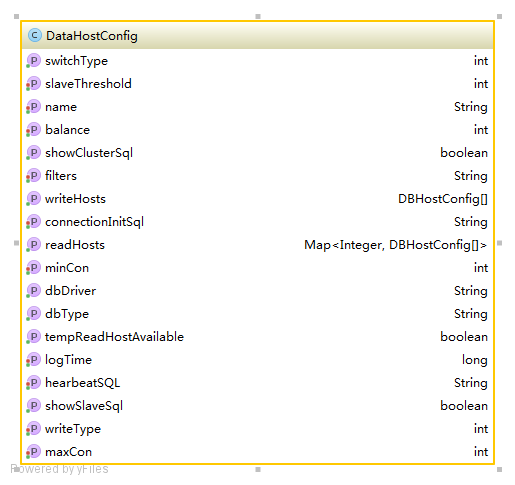資料庫路由中介軟體MyCat - 原始碼篇(12)
阿新 • • 發佈:2018-11-07
此文已由作者張鎬薪授權網易雲社群釋出。
歡迎訪問網易雲社群,瞭解更多網易技術產品運營經驗。
NodeList ruleNodes = e.getElementsByTagName("rule");
int length = ruleNodes.getLength();
if (length > 1) {
throw new ConfigException("only one rule can defined :"
+ name);
}
//目前只處理第一個,未來可能有多列複合邏輯需求
//RuleConfig是儲存著rule與function對應關係的物件
RuleConfig rule = loadRule((Element) ruleNodes.item(0));
String funName = rule.getFunctionName();
//判斷function是否存在,獲取function
AbstractPartitionAlgorithm func = functions.get(funName);
if (func == null) {
throw new ConfigException("can't find function of name :"
+ funName);
}
rule.setRuleAlgorithm(func);
//儲存到tableRules
tableRules.put(name, new TableRuleConfig(name, rule));
}
}
}這樣,所有的tableRule和function就載入完畢。儲存在一個變數中,就是tableRules:XMLRuleLoader.java:
private final Map<String, TableRuleConfig> tableRules;
4.2 schema.xml:
public XMLSchemaLoader(String schemaFile, String ruleFile) { //先讀取rule.xml
XMLRuleLoader ruleLoader = new XMLRuleLoader(ruleFile); //將tableRules拿出,用於這裡載入Schema做rule有效判斷,以及之後的分片路由計算
this.tableRules = ruleLoader.getTableRules(); //釋放ruleLoader
ruleLoader = null; this.dataHosts = new HashMap<String, DataHostConfig>(); this.dataNodes = new HashMap<String, DataNodeConfig>(); this.schemas = new HashMap<String, SchemaConfig>(); //讀取載入schema配置
this.load(DEFAULT_DTD, schemaFile == null ? DEFAULT_XML : schemaFile);
}private void load(String dtdFile, String xmlFile) {
InputStream dtd = null;
InputStream xml = null; try {
dtd = XMLSchemaLoader.class.getResourceAsStream(dtdFile);
xml = XMLSchemaLoader.class.getResourceAsStream(xmlFile);
Element root = ConfigUtil.getDocument(dtd, xml).getDocumentElement(); //先載入所有的DataHost
loadDataHosts(root); //再載入所有的DataNode
loadDataNodes(root); //最後載入所有的Schema
loadSchemas(root);
} catch (ConfigException e) { throw e;
} catch (Exception e) { throw new ConfigException(e);
} finally { if (dtd != null) { try {
dtd.close();
} catch (IOException e) {
}
} if (xml != null) { try {
xml.close();
} catch (IOException e) {
}
}
}
}先看下DataHostConfig這個類的結構: 
private void loadDataHosts(Element root) {
NodeList list = root.getElementsByTagName("dataHost"); for (int i = 0, n = list.getLength(); i < n; ++i) {
Element element = (Element) list.item(i);
String name = element.getAttribute("name"); //判斷是否重複
if (dataHosts.containsKey(name)) { throw new ConfigException("dataHost name " + name + "duplicated!");
} //讀取最大連線數
int maxCon = Integer.valueOf(element.getAttribute("maxCon")); //讀取最小連線數
int minCon = Integer.valueOf(element.getAttribute("minCon")); /**
* 讀取負載均衡配置
* 1. balance="0", 不開啟分離機制,所有讀操作都發送到當前可用的 writeHost 上。
* 2. balance="1",全部的 readHost 和 stand by writeHost 參不 select 的負載均衡
* 3. balance="2",所有讀操作都隨機的在 writeHost、readhost 上分發。
* 4. balance="3",所有讀請求隨機的分發到 wiriterHost 對應的 readhost 執行,writerHost 不負擔讀壓力
*/
int balance = Integer.valueOf(element.getAttribute("balance")); /**
* 讀取切換型別
* -1 表示不自動切換
* 1 預設值,自動切換
* 2 基於MySQL主從同步的狀態決定是否切換
* 心跳詢句為 show slave status
* 3 基於 MySQL galary cluster 的切換機制
*/
String switchTypeStr = element.getAttribute("switchType"); int switchType = switchTypeStr.equals("") ? -1 : Integer.valueOf(switchTypeStr); //讀取從延遲界限
String slaveThresholdStr = element.getAttribute("slaveThreshold"); int slaveThreshold = slaveThresholdStr.equals("") ? -1 : Integer.valueOf(slaveThresholdStr); //如果 tempReadHostAvailable 設定大於 0 則表示寫主機如果掛掉, 臨時的讀服務依然可用
String tempReadHostAvailableStr = element.getAttribute("tempReadHostAvailable");
boolean tempReadHostAvailable = tempReadHostAvailableStr.equals("") ? false : Integer.valueOf(tempReadHostAvailableStr) > 0; /**
* 讀取 寫型別
* 這裡只支援 0 - 所有寫操作僅配置的第一個 writeHost
*/
String writeTypStr = element.getAttribute("writeType"); int writeType = "".equals(writeTypStr) ? PhysicalDBPool.WRITE_ONLYONE_NODE : Integer.valueOf(writeTypStr);
String dbDriver = element.getAttribute("dbDriver");
String dbType = element.getAttribute("dbType");
String filters = element.getAttribute("filters");
String logTimeStr = element.getAttribute("logTime"); long logTime = "".equals(logTimeStr) ? PhysicalDBPool.LONG_TIME : Long.valueOf(logTimeStr) ; //讀取心跳語句
String heartbeatSQL = element.getElementsByTagName("heartbeat").item(0).getTextContent(); //讀取 初始化sql配置,用於oracle
NodeList connectionInitSqlList = element.getElementsByTagName("connectionInitSql");
String initConSQL = null; if (connectionInitSqlList.getLength() > 0) {
initConSQL = connectionInitSqlList.item(0).getTextContent();
} //讀取writeHost
NodeList writeNodes = element.getElementsByTagName("writeHost");
DBHostConfig[] writeDbConfs = new DBHostConfig[writeNodes.getLength()];
Map<Integer, DBHostConfig[]> readHostsMap = new HashMap<Integer, DBHostConfig[]>(2); for (int w = 0; w < writeDbConfs.length; w++) {
Element writeNode = (Element) writeNodes.item(w);
writeDbConfs[w] = createDBHostConf(name, writeNode, dbType, dbDriver, maxCon, minCon,filters,logTime);
NodeList readNodes = writeNode.getElementsByTagName("readHost"); //讀取對應的每一個readHost
if (readNodes.getLength() != 0) {
DBHostConfig[] readDbConfs = new DBHostConfig[readNodes.getLength()]; for (int r = 0; r < readDbConfs.length; r++) {
Element readNode = (Element) readNodes.item(r);
readDbConfs[r] = createDBHostConf(name, readNode, dbType, dbDriver, maxCon, minCon,filters, logTime);
}
readHostsMap.put(w, readDbConfs);
}
}
DataHostConfig hostConf = new DataHostConfig(name, dbType, dbDriver,
writeDbConfs, readHostsMap, switchType, slaveThreshold, tempReadHostAvailable);
hostConf.setMaxCon(maxCon);
hostConf.setMinCon(minCon);
hostConf.setBalance(balance);
hostConf.setWriteType(writeType);
hostConf.setHearbeatSQL(heartbeatSQL);
hostConf.setConnectionInitSql(initConSQL);
hostConf.setFilters(filters);
hostConf.setLogTime(logTime);
dataHosts.put(hostConf.getName(), hostConf);
}
}先讀取每個DataHost的通用配置,之後讀取每個DataHost對應的writeHost以及每個writeHost對應的readHost。配置好後,儲存在:
private final Map<String, DataHostConfig> dataHosts;
之後讀取載入DataHost: XMLSchemaLoader.java:
private void loadDataNodes(Element root) { //讀取DataNode分支
NodeList list = root.getElementsByTagName("dataNode"); for (int i = 0, n = list.getLength(); i < n; i++) {
Element element = (Element) list.item(i);
String dnNamePre = element.getAttribute("name");
String databaseStr = element.getAttribute("database");
String host = element.getAttribute("dataHost"); //字串不為空
if (empty(dnNamePre) || empty(databaseStr) || empty(host)) { throw new ConfigException("dataNode " + dnNamePre + " define error ,attribute can't be empty");
} //dnNames(name),databases(database),hostStrings(dataHost)都可以配置多個,以',', '$', '-'區分,但是需要保證database的個數*dataHost的個數=name的個數
//多個dataHost與多個database如果寫在一個標籤,則每個dataHost擁有所有database
//例如:<dataNode name="dn1$0-75" dataHost="localhost$1-10" database="db$0-759" />
//則為:localhost1擁有dn1$0-75,localhost2也擁有dn1$0-75(對應db$76-151)
String[] dnNames = io.mycat.util.SplitUtil.split(dnNamePre, ',', '$', '-');
String[] databases = io.mycat.util.SplitUtil.split(databaseStr, ',', '$', '-');
String[] hostStrings = io.mycat.util.SplitUtil.split(host, ',', '$', '-'); if (dnNames.length > 1 && dnNames.length != databases.length * hostStrings.length) { throw new ConfigException("dataNode " + dnNamePre
+ " define error ,dnNames.length must be=databases.length*hostStrings.length");
} if (dnNames.length > 1) {
List<String[]> mhdList = mergerHostDatabase(hostStrings, databases); for (int k = 0; k < dnNames.length; k++) {
String[] hd = mhdList.get(k);
String dnName = dnNames[k];
String databaseName = hd[1];
String hostName = hd[0];
createDataNode(dnName, databaseName, hostName);
}
} else {
createDataNode(dnNamePre, databaseStr, host);
}
}
}private void createDataNode(String dnName, String database, String host) {
DataNodeConfig conf = new DataNodeConfig(dnName, database, host);
if (dataNodes.containsKey(conf.getName())) { throw new ConfigException("dataNode " + conf.getName() + " duplicated!");
} if (!dataHosts.containsKey(host)) { throw new ConfigException("dataNode " + dnName + " reference dataHost:" + host + " not exists!");
}
dataNodes.put(conf.getName(), conf);
}
生成的是DataNode類,放入:
private final Map<String, DataNodeConfig> dataNodes;
更多網易技術、產品、運營經驗分享請點選。
相關文章:
【推薦】 react-native自定義原生元件
